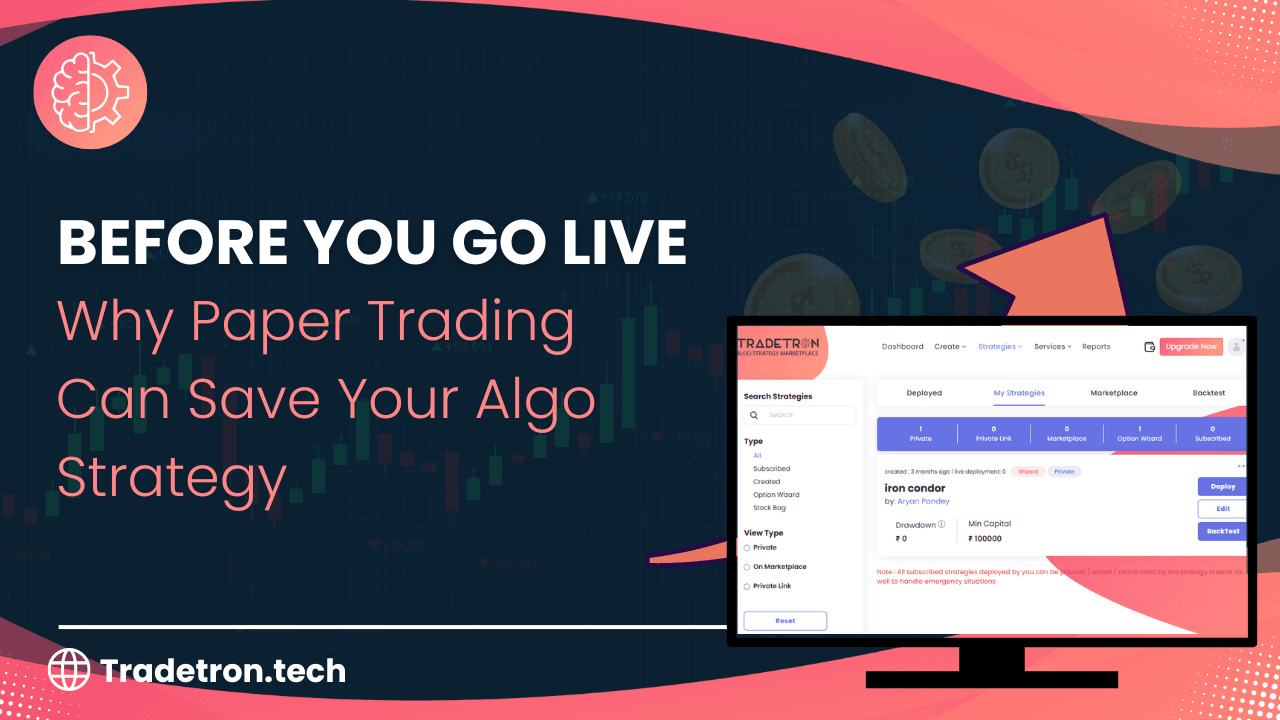Algorithmic trading promises automation, precision, and consistency—but only if your strategy actually works in real market conditions. Many traders build complex logics and rush to go live, only to watch their capital shrink due to a small flaw or a misunderstood market trigger.
Before putting real money at risk, there’s one essential step smart algo traders take: paper trading.
In this blog, we’ll explore why paper trading is non-negotiable in algo trading, how it can uncover weaknesses in your logic, and how platforms like Tradetron make it easy to simulate real trades before you deploy live.

What Is Paper Trading in Algo?
Paper trading is a method of testing your algorithmic strategies in real-time market conditions—without using real money. Your trades are placed virtually, and everything from entry to exit is executed based on your logic, just as it would be in a live environment.
The benefit? You experience how your strategy performs live, with zero financial risk.
Why Paper Trading Can Save You
1. Catch Hidden Logic Flaws
Even if your backtest results look promising, your live environment introduces variables that historical data can’t predict—like order execution delays, volatility spikes, or conditional overlaps. Paper trading helps identify:
Misfires in logic
Double entries
Missed exits
Timing mismatches
2. Validate Real-Time Performance
Backtesting shows what would have happened. Paper trading shows what is happening right now. You’ll learn:
How your strategy reacts to sudden news
How often it triggers trades
Whether your entry/exit rules actually align with live price action
3. Fine-Tune Entry and Exit Rules
A few seconds can make or break a trade in algo execution. Paper trading allows you to:
Adjust your timing logic
Optimize stop-loss and target levels
Experiment with filters (e.g., volume, candle confirmations, etc.)
4. Avoid Emotional or Premature Live Launch
Going live without confidence leads to second-guessing and unnecessary panic exits. With paper trading:
You build emotional detachment
You gain statistical proof of your system
You’re more likely to stick to your logic under pressure
5. Improve Strategy Scalability
Want to run the same strategy across multiple instruments or time frames? Test it on paper first. You can simulate scalability across:
Different symbols (e.g., Bank Nifty, Nifty, or stocks)
Multiple time intervals
Varying market conditions
How to Paper Trade on Platforms Like Tradetron
Tradetron allows you to build, deploy, and test algo strategies without writing a single line of code. Here’s how:
Create Strategy
Use conditions, indicators, and position logic in Tradetron’s visual builder.Choose Paper Trading Exchange
Select “Paper Trading” during deployment to simulate trades.Monitor Performance
Track metrics like profit/loss, drawdown, win rate, average return, etc.Make Adjustments
Refine logic, optimize rules, and test variations—risk-free.Go Live with Confidence
Once paper trades show consistency for 2–4 weeks, you’re ready to switch to a real broker.
Mistakes to Avoid
Not treating it seriously: Don’t take unnecessary risks just because it's fake money.
Overfitting strategy logic: Don’t tweak endlessly just to get "perfect" paper results.
Ignoring execution timing: Paper trading helps uncover lags—watch the exact execution time.
Skipping strategy notes: Maintain a log of what works, what fails, and what changed.
Delaying live too long: Once consistent, go live with small capital to gather real feedback.
Real-World Example
Let’s say you’ve built a moving average crossover strategy. Your backtest shows 65% win rate. But in paper mode, you notice:
It over-trades during sideways markets
It exits too early during trending moves
Stop-loss hits more than expected due to slippage
These insights would have cost real money. Paper trading gives you a free preview of what could go wrong—and time to fix it.
Conclusion
Algo trading is all about trusting the system you’ve built. But you can’t trust what you haven’t tested.
Paper trading is the rehearsal before the real show. It’s where bugs get fixed, logic gets tightened, and confidence gets built.
If you’re using a platform like Tradetron, there’s no excuse to skip this step. Test smarter—before you trade harder.
Frequently Asked Questions (FAQs)
1. Is paper trading the same as backtesting?
No. Backtesting uses historical data; paper trading runs your strategy in real-time without using real money.
2. How long should I paper trade before going live?
Ideally 2–4 weeks or until your strategy shows consistent results with manageable risk.
3. Can I fully automate paper trades?
Yes. Platforms like Tradetron allow 100% automated logic execution even in paper mode.
4. Will paper trading show me slippage and execution delay?
Not exactly. But it gives you live-market exposure to monitor trigger timings and identify potential slippage zones.
5. Can I track performance like in live trading?
Absolutely. You get dashboards showing profit/loss, trade history, drawdowns, and more—just like in live mode.



 Made with Superblog
Made with Superblog